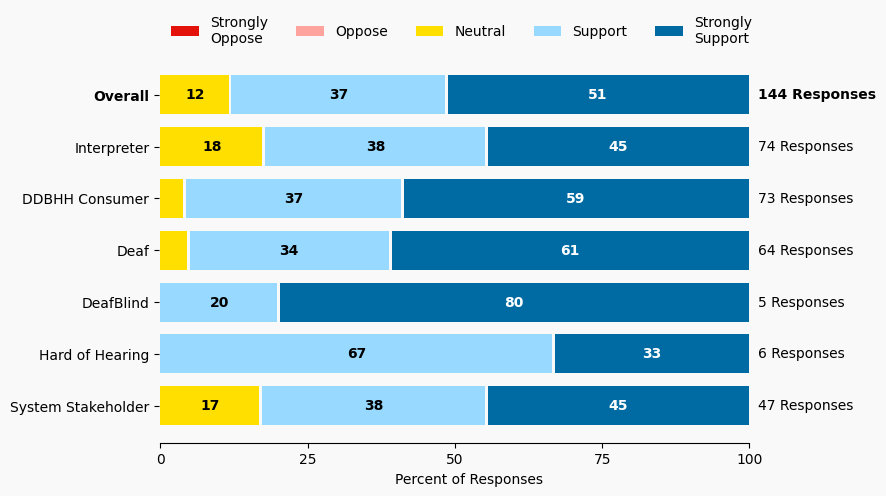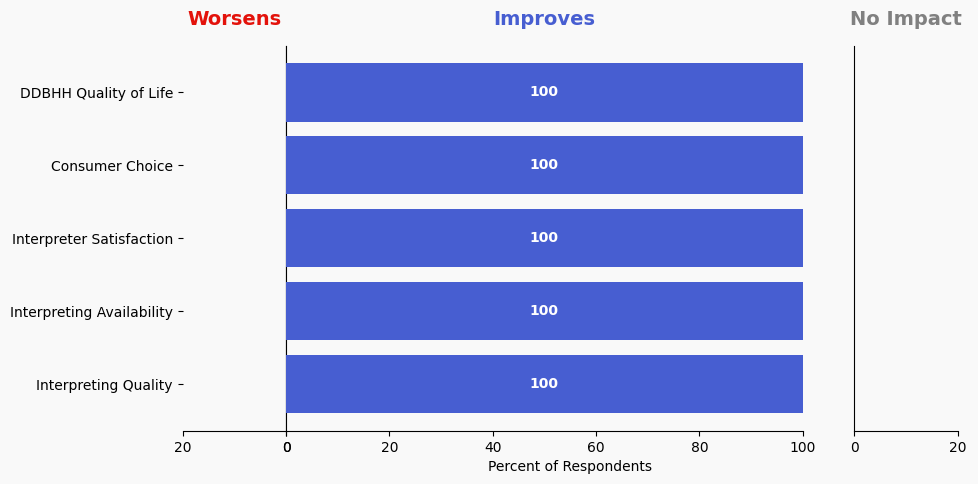4 Educate Potential Hiring Entities & Employers: ADA Responsibilities
Issue: Organizations who need to hire interpreters often do not understand how to obtain quality and qualified interpreting services
Proposed Solution: Coalition, with Commission and DEED VRS leading, coordinate gathering of already existing resources and the development of new resources. The goal is to provide easily accessible training and resources to help employers and service providers understand communication access and accommodations. An example of a training resource is “industry standards and potential associated costs to expect when hiring interpreters.” Enhance and more widely publicize the existing State Services resource website. The audience is employers of all different sizes.
Expected outcome: DDBHH people will experience increased and better services when interacting with any employers.
Who is impacted: Consumers, hiring entities, including employers and service providers, interpreters
Update 9/9/24: DEED’s ERAF includes serving as a resource to educate and advise employers.
Timeline: 6 months

Summary of Support Image Description
The stacked bar charts show how respondents rated their level of support and the total number of responses. The percentage for the five support levels is shown from left to right: Strongly Oppose (Dark Red), Oppose (Light Red), Neutral (Yellow), Support (Light Blue), and Strongly Support (Dark Blue).
Respondents may identify with multiple subgroups. The overall level of support is:
Overall
Strongly Oppose: 0%
Oppose: 0%
Neutral: 12%
Support: 37%
Strongly Support: 51%
Click to see the detailed image description for each subgroup.
Interpreter
Strongly Oppose: 0%
Oppose: 0%
Neutral: 18%
Support: 38%
Strongly Support: 45%
Deaf
Strongly Oppose: 0%
Oppose: 0%
Neutral: 5%
Support: 34%
Strongly Support: 61%
DDBHH Consumer
Strongly Oppose: 0%
Oppose: 0%
Neutral: 4%
Support: 37%
Strongly Support: 59%
DeafBlind
Strongly Oppose: 0%
Oppose: 0%
Neutral: 0%
Support: 20%
Strongly Support: 80%
System Stakeholder
Strongly Oppose: 0%
Oppose: 0%
Neutral: 17%
Support: 38%
Strongly Support: 45%
Hard of Hearing
Strongly Oppose: 0%
Oppose: 0%
Neutral: 0%
Support: 67%
Strongly Support: 33%
Overview of Respondents Opting for In-Depth Solution Analysis
After indicating their support level, 2% of the 144 respondents opted in to further assess whether the solution would worsen or improve on five metrics. Of the opt-in reviewers (4 respondents), 100% supported the solution, 0% were neutral on the solution, and 0% opposed the solution.
The remaining 140 respondents did not opt in to further assess the solution. Of these people, 87% support the solution, 12% were neutral on the solution, and 0% opposed the solution.
Reviewer Evaluation of Solution Effectiveness

Solution Effectiveness Image Description
The stacked bar charts show how respondents assessed the effectiveness of this solution based on five metrics. For each metric, the percentage of respondents is shown from left to right: Worsens (Red), Improves (Blue), No Impact (Gray).
DDBHH Quality of Life
Makes It Worse 0%
Makes It Better 100%
No Impact 0%
Interpreter Satisfaction
Makes It Worse 0%
Makes It Better 100%
No Impact 0%
Consumer Choice
Makes It Worse 0%
Makes It Better 100%
No Impact 0%
Interpreting Availability
Makes It Worse 0%
Makes It Better 100%
No Impact 0%
Interpreting Quality
Makes It Worse 0%
Makes It Better 100%
No Impact 0%
Reviewer Feedback and Insights
Interpreter
No comments were submitted.
Deaf, DeafBlind, Hard of Hearing
No comments were submitted.
System Stakeholder
Comments from System stakeholders include a suggestion to partner with the MN HR Chapter to provide ADA training as a CEU for HR professionals.
PREVIOUS SOLUTION
Issue: The Minnesota Judicial Branch (MJB) ADA Grievance Procedure and Complaint Process are not well publicized to the DDBHH constituents who interact with the courts.
NEXT SOLUTION
5 Educate All Entities on ADA Responsibilities and How to Access Interpreters
Issue: All organizations who need to hire interpreters often do not understand how to obtain quality and qualified interpreting services
Leave a Reply